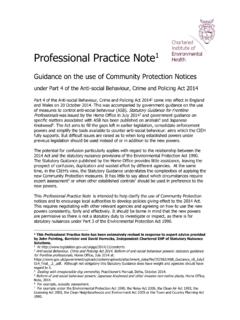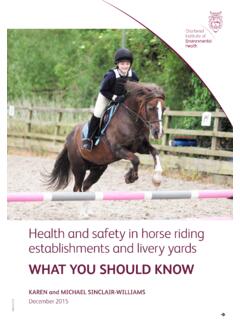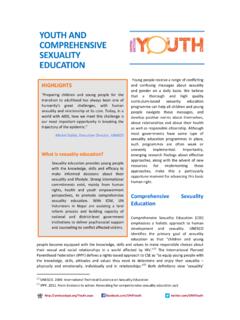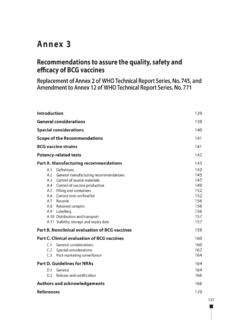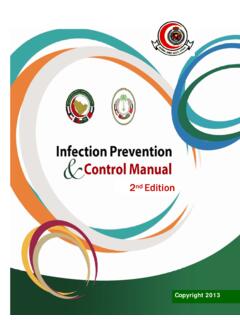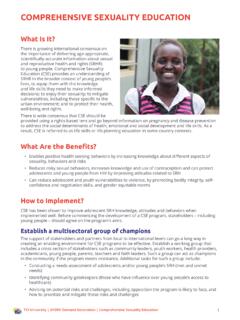Transcription of Tattooing and guidance Toolkit - CIEH
1 Main contentsTattooing and body piercing guidanceToolkitISBN 978-1-906989-72-9 July and body piercing guidanceFOREWORD 2 ENDORSING ORGANISATIONS 3 INTRODUCTION 4 5 USING THE guidance Toolkit 6 ACKNOWLEDGEMENTS 7 part ASection 01 8 14 Legislative background on Tattooing and skin piercing activitiesSection 02a 15 Standard Principles of Infection Control Section 02b 16 17 Principles of Infection Control Hand hygieneSection 02c 18 20 Principles of Infection Control Personal protective equipment Section 02d 21 23 Principles of Infection Control Management of sharps and exposure to blood and body fluidsSection 02e 24 25 Principles of Infection Control Safe handling, storage and disposal of waste materialsSection 02f 26 Principles of Infection Control Cleaning and disinfection of the environmentSection 02g 27 ReferencesSection 03 28 29 Before and aftercare of a tattoo or body piercingSection 04 30 34 DecontaminationSection 05 35 36 Product quality of tattoo inkSection 06 37 body piercing jewellerySection 07 38 39 GovernanceSection 08 40 Management of infectious disease incidents relating to Tattooing and body piercing part BAppendix 01 41 Model Byelaws.
2 Acupuncture, Tattooing , semi-permanent skin-colouring, cosmetic piercing and electrolysisAppendix 02 42 43 Infection, its causes and spread, including a glossary of infection-related termsAppendix 03 44 Blood borne virusesAppendix 04 45 Safe use and disposal of sharpsAppendix 05 46 First Aid following a blood/ body fluid exposure Appendix 06 47 Protocol for cleaning up blood or a blood stained body fluid spillAppendix 07 48 Principles for good waste handlingAppendix 08 49 Template protocol for environmental cleaning of premisesAppendix 09 50 Tattooing / body piercing consent formAppendix 10 51 Aftercare follow-up record sheetAppendix 11 52 Decontamination requirements for equipment used in Tattooing and skin piercingAppendix 12 53 Equipment sterilization standard- self assessment and decision making tool for tattoo and body piercing practitionersAppendix 13 54 Equipment and body piercing jewellery sterilization standard for tattooists and body piercersAppendix 14 55 Autoclave daily record sheetPART CLeaflets
3 To download and print out01 Tattoo aftercare 5602 Ear and face piercing aftercare 5703 Oral piercing aftercare 5804 body and surface piercing aftercare 5905 Genital piercing (female) aftercare 6006 Genital piercing (male) aftercare 6107 Microdermal implants aftercare 62 Poster to downloadHow to handwash 63 part DAudit Tool to download 64 part ELiterature review to download 65 CONTENTSC lick on text to view2 Main contentsToolkitTattooing and body piercing guidanceGRAHAM JUKESC hief Executive, Chartered Institute of Environmental HealthTattooing and body piercing have become increasingly popular and fashionable. Ensuring practitioners follow safe working practices is important for protection of both clients and the practitioners themselves. It has been recognized for some time that there is a need to promote safety and consistency across the range of Tattooing and body piercing practices by basing requirements on best available scientific information whilst also taking account of practical experience.
4 This guidance Toolkit encompasses expert advice as well as the opinions and experience of practitioners of what works at a practical level. ALAN BESWICKP rincipal Scientist, Health & Safety Laboratory A substantial amount of care and effort has gone in to producing this new guidance Toolkit , and its underlying strength lies in the evidence based nature of its content; further supported by expert consensus where published evidence may be lacking. The combination of contributors to the Toolkit confirms the desire of the authors to get it right in terms of the subject matter, presentation style and general accessibility of the information. Those who have contributed include senior Tattooing and body piercing industry representatives, health care professionals, infection control scientists and health and safety specialists. The Health and Safety Laboratory is grateful to Public Health England and The Chartered Institute of Environmental Health for the opportunity to be involved in this guidance Toolkit preparation, and is fully supportive of its PAUL COSFORDD irector for Health Protection and Medical Director, Public Health EnglandThis guidance Toolkit has been developed as a collaborative piece of work between health protection staff and partners for the tattoo and body piercing industry.
5 Its aim is to influence service provision, in particular by the promotion of evidence based infection prevention and control practice. This information has been adapted into a comprehensive, practically based governance framework as a resource to both support and guide practitioners in the field. The need for and importance of this guidance for the industry, has been recognised by many health professionals and practitioners alike and I am delighted to support and endorse this Toolkit HENDERSONP resident, Tattoo and piercing Industry UnionThe vast majority of members of the professional tattoo and body piercing community recognise the importance of the promotion and adoption of good practice in order to safeguard both practitioners and public alike. It is our hope that this document will provide an easy access reference guide to assist those engaged in the industry in understanding the necessity for examining their current practices and, where needed, making changes to improve operational standards.
6 FOREWORDC lick on text to viewFOREWORDENDORSING ORGANISATIONSINTRODUCTIONUSING THE guidance TOOLKITACKNOWLEDGEMENTS3 Main contentsToolkitTattooing and body piercing guidanceCHARTERED INSTITUTE OF ENVIRONMENTAL HEALTH (CIEH)The CIEH is a registered charity and the professional voice for environmental health. It sets standards, accredits courses and qualifications for the education of members and other environmental health practitioners. It provides information, evidence and policy advice to local and national government and environmental and public health practitioners in the public and private sectors. As an awarding body , the CIEH provides qualifications, events, and support materials on topics relevant to health, wellbeing and safety to develop workplace skills and best AND SAFETY LABORATORY (HSL)The Health and Safety Laboratory (HSL) is an Agency of Health and Safety Executive (HSE) and is the UK s leading health and safety research facility, employing over 350 scientific, medical and technical specialists.
7 Its role is to support the HSE Mission and directly help organisations become healthier, safer and therefore, more productive places in which to work. HSL capabilities encompass a wide range of topics including: occupational and environmental health, human factors and risk assessment; safety engineering; work environment and specialist photographic and technical services. This breadth of expertise underpins our particular strength in creating multi-disciplinary teams to solve health and safety HEALTH ENGLAND (PHE)From its establishment in April 2013, Public Health England is the authoritative national voice and expert service provider for public health, established to protect and improve the nation s health and wellbeing, and to reduce inequalities. The three main business functions: 1. Delivering services to national and local government, the NHS and the public. 2. Leading for public health.
8 3. Supporting the development of the specialist and wider public health workforce. PHE works with partners across the public health system and in wider society to: Deliver, support and enable improvements in health and wellbeing in the areas set out in the Public Health Outcomes Framework. Lead on the design, delivery and maintenance of systems to protect the population against existing and future threats to health by providing a comprehensive range of health protection AND piercing INDUSTRY UNION (TPIU)The TPIU has been working hard to become the recognised trade association representing individual TPI workers and their studios; providing a collective voice for the industry; helping to educate and inform our members on issues specific to our profession and to raise standards in the industry through sharing of information and ORGANISATIONS Click on text to viewFOREWORDENDORSING ORGANISATIONSINTRODUCTIONUSING THE guidance TOOLKITACKNOWLEDGEMENTS4 Main contentsToolkitTattooing and body piercing guidanceINTRODUCTIONThis guidance Toolkit has been prepared by a panel of health protection and practitioner representatives.
9 It comprises a consensus of expert advice which it is intended will provide an authoritative source of information. Its contents are supported by extensive literature reviews ( part E).The purpose of the guidance Toolkit is to support local authority and other regulatory officers in determining their requirements for effective control of risk in these activities and to promote a consistent approach. Similarly, it is intended to be of assistance to practitioners and businesses undertaking these activities to support them in adopting acceptable standards of practice. The use of this guidance Toolkit will help to ensure the health and safety of both clients and operators and that Tattooing and skin piercing practitioners will be operating in compliance with legal and body piercing procedures have become more popular and fashionable in the United Kingdom (UK) as a whole, particularly in the last decade.
10 The range of Tattooing and body piercing procedures has also increased. There are no published data on the prevalence of tattoos in the general UK population. There are also no comprehensive data for the UK on the prevalence of body piercing , but a small study has estimated that the prevalence of body piercing , other than of earlobes, in the general adult population in England was 10% (Bone A et al, 2008). There are known and well reported health risks which can be attributed to these procedures, as well as associated legal issues. Improper and unhygienic practice may result in localised skin infections at the site of the tattoo or piercing . There is also the risk of transmission of blood-borne viruses, for example Hepatitis B, Hepatitis C, Hepatitis D or HIV, which can have more serious and long term health consequences. It is therefore important that practitioners have safe working practices, and particularly that good infection control practices are followed at all times, so that both clients and practitioners are the years a variety of legislation has been introduced, mainly for local adoption, to encourage and support safe practice.
